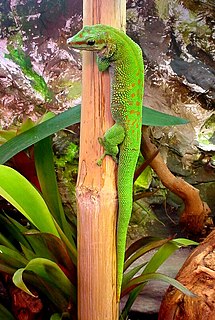
The Madagascar day gecko is a diurnal species of gecko. It lives on the eastern coast of Madagascar and typically inhabits rainforests and dwells on trees. The Madagascar day gecko feeds on insects, fruit and nectar.
Phelsuma astriata semicarinata is a subspecies of Seychelles day gecko. It is a small, slender gecko, has a bright green colour and feeds on insects. It is found on different islands of the Seychelles, where it often lives near human dwellings.
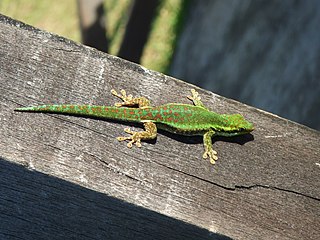
The Reunion Island day gecko is a species of gecko. It is diurnal and lives in northern Réunion. It typically dwells on banana trees and feeds on insects and nectar.
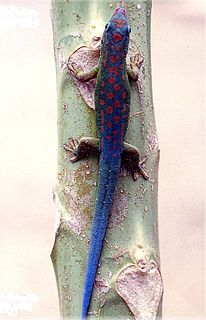
The blue-tailed day gecko is a diurnal species of gecko, a lizard in the family Gekkonidae. The species is endemic to the island Mauritius. It typically inhabits warm and humid places and dwells on different trees and bushes.

Phelsuma dubia, dull day gecko, olive day gecko, Zanzibar day gecko, or green day gecko is a diurnal species of gecko. It is about 15 centimetres (5.9 in) in length and lives on the western coast of Madagascar, in the Comoros, and the coast of East Africa. It typically inhabits trees and can also be found near human dwellings. The Dull day gecko feeds on insects and nectar.
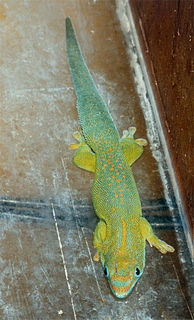
The yellow-throated day gecko is an endangered diurnal species of gecko from eastern Madagascar. It typically inhabits rainforests and dwells on trees. The yellow-throated day gecko feeds on insects and nectar.

The speckled day gecko is a diurnal species of geckos. It lives in eastern Madagascar and typically inhabits rainforests and dwells on trees. The speckled day gecko feeds on insects and nectar.
Reunion Island ornate day gecko or Manapany day gecko is a critically endangered diurnal species of gecko. It occurs only on the island of Réunion in the Indian Ocean, typically inhabits trees, and feeds on insects and nectar.

The gold dust day gecko is a diurnal species of gecko. It lives in northern Madagascar, and on the island of Comoros; it has also been introduced to Hawaii and other Pacific islands. It's typically seen in houses and various trees. The gold dust day gecko feeds on insects and nectar. It is commonly known as the mascot of GEICO.

Koch's giant day gecko is a diurnal subspecies of gecko, a lizard in the family Gekkonidae. The subspecies is native to northwestern and western Madagascar and typically inhabits trees. It feeds on insects and nectar.

Robert Mertens's day gecko is diurnal species of lizard in the family Gekkonidae. The species is endemic to the Comoros.
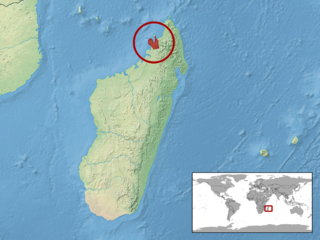
Seipp's day gecko is an endangered diurnal species of lizard in the family Gekkonidae. The species is native to northern Madagascar, typically inhabits rainforests, dwells on trees, and feeds on insects and nectar.
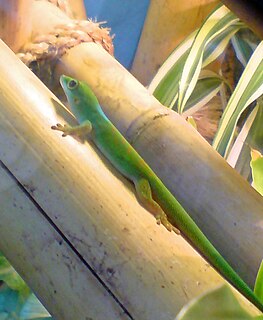
Pasteur's day gecko is a small diurnal subspecies of gecko. It lives in the Comoros and typically inhabits trees and bushes. Pasteur's day gecko feeds on insects and nectar.
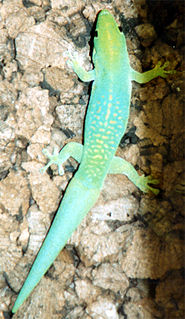
Phelsuma v-nigra v-nigraBoettger, 1913 is a small diurnal subspecies of geckos. It lives in the Comoros and typically inhabits trees and bushes. Phelsuma v-nigra v-nigra feeds on insects and nectar.
The Grand Comoro Day Gecko is a small diurnal subspecies of geckos. It lives in the Comoros and typically inhabits trees and bushes. The Grand Comoro day gecko feeds on insects and nectar.
Anjouan Island day gecko is a small diurnal subspecies of geckos. It lives in the Comoros and typically inhabits trees and bushes. The Anjouan Island day gecko feeds on insects and nectar.
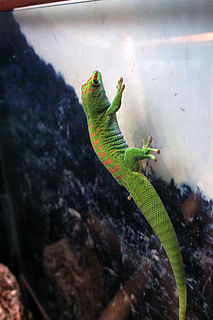
Seychelles giant day gecko is diurnal subspecies of geckos. It lives on the island Praslin in the Seychelles and typically inhabits trees and dwellings. The Seychelles giant day gecko feeds on insects and nectar.
Phelsuma sundbergi ladiguensis is a diurnal subspecies of Phelsuma sundbergi. It lives on the islands Ladigue, Felicite and Cocco in the Seychelles, and typically inhabits trees and dwellings. The Seychelles giant day gecko feeds on insects and nectar.

Mahé day gecko is a diurnal subspecies of geckos. It lives on the western granite islands of the Seychelles and typically inhabits trees and human dwellings. The Seychelles giant day gecko feeds on insects and nectar.
The Phelsuma pusilla pusillaMertens, 1964 is a diurnal gecko and lives in eastern Madagascar. It typically inhabits different trees and houses. This day gecko feeds on insects and nectar.













